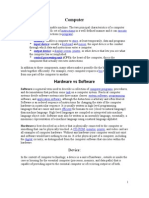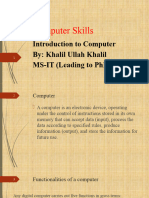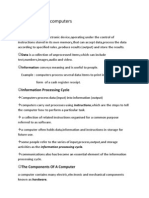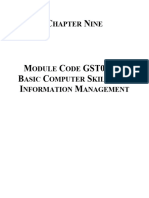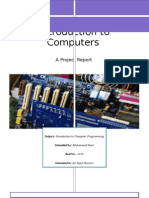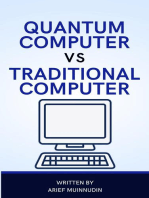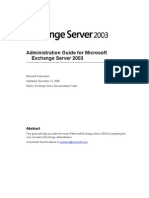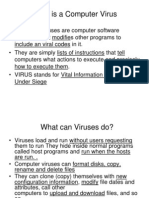Computer Basic Definition
Uploaded by
amuljuneComputer Basic Definition
Uploaded by
amuljunecomputer
A programmable machine. The two principal characteristics of a computer are: It responds to a specific set of instructions in a well-defined manner.
It can execute a prerecorded list of instructions (a program).
Modern computers are electronic and digital. The actual machinery -- wires, transistors, and circuits -- is called hardware; the instructions and data are called software. All general-purpose computers require the following hardware components: memory : Enables a computer to store, at least temporarily, data and programs. mass storage device : Allows a computer to permanently retain large amounts of data. Common mass storage devices include disk drives and tape drives.
input device : Usually a keyboard and mouse, the input device is the conduit through which data and instructions enter a computer. output device : A display screen, printer, or other device that lets you see what the computer has accomplished. central processing unit (CPU): The heart of the computer, this is the component that actually executes instructions. In addition to these components, many others make it possible for the basic components to work together efficiently. For example, every computer requires a bus that transmits data from one part of the computer to another. Computers can be generally classified by size and power as follows, though there is considerable overlap: personal computer : A small, single-user computer based on a microprocessor. In addition to the microprocessor, a personal computer has a keyboard for entering data, a monitor for displaying information, and a storage device for saving data. workstation : A powerful, single-user computer. A workstation is like a personal computer, but it has a more powerful microprocessor and a higherquality monitor. minicomputer : A multi-user computer capable of supporting from 10 to hundreds of users simultaneously. mainframe : A powerful multi-user computer capable of supporting many hundreds or thousands of users simultaneously. supercomputer : An extremely fast computer that can perform hundreds of millions of instructions per second.
You might also like
- Computer Classification, by Size and Power: Display Screen PrinterNo ratings yetComputer Classification, by Size and Power: Display Screen Printer1 page
- Generation Highlights Important Details: ComputerNo ratings yetGeneration Highlights Important Details: Computer1 page
- Componants of Computer Computer Defination: 1) Central Processing UnitNo ratings yetComponants of Computer Computer Defination: 1) Central Processing Unit5 pages
- Modern Computers Defined: Instructions Execute ProgramNo ratings yetModern Computers Defined: Instructions Execute Program2 pages
- Personal Computer Parts: Central Processing UnitNo ratings yetPersonal Computer Parts: Central Processing Unit3 pages
- Computer Terminology - Types of ComputersNo ratings yetComputer Terminology - Types of Computers25 pages
- Ryan College of Engineering Computer Engineering PC Architecture & MaintenanceNo ratings yetRyan College of Engineering Computer Engineering PC Architecture & Maintenance10 pages
- Computer: You Learn The Concept of Computer, Miscrosoft, and Many MoreNo ratings yetComputer: You Learn The Concept of Computer, Miscrosoft, and Many More6 pages
- Caring For Network and Computer HardwareNo ratings yetCaring For Network and Computer Hardware18 pages
- CSEC Information Technology Notes Objective - 1.1100% (1)CSEC Information Technology Notes Objective - 1.12 pages
- Basic Elements of A Computer System Are Mouse, Keyboard, Monitor, Memory, CPU, Motherboard, Hard Disk, Speakers, Modem, Power Supply, and ProcessorNo ratings yetBasic Elements of A Computer System Are Mouse, Keyboard, Monitor, Memory, CPU, Motherboard, Hard Disk, Speakers, Modem, Power Supply, and Processor28 pages
- First Generation (1940-1956) Vacuum Tubes: Magnetic Drums MemoryNo ratings yetFirst Generation (1940-1956) Vacuum Tubes: Magnetic Drums Memory3 pages
- CSC 100 Fundamentals of Computing: Computer BasicsNo ratings yetCSC 100 Fundamentals of Computing: Computer Basics52 pages
- Lec3 - An Introduction To Computer SystemsNo ratings yetLec3 - An Introduction To Computer Systems74 pages
- Introduction To Computer Programming Project ReportNo ratings yetIntroduction To Computer Programming Project Report27 pages
- How To Install Windows Server 2008 Step by StepNo ratings yetHow To Install Windows Server 2008 Step by Step14 pages
- Administration Guide For Microsoft Exchange Server 2003No ratings yetAdministration Guide For Microsoft Exchange Server 2003473 pages
- Active Directory Interview Questions and AnswersNo ratings yetActive Directory Interview Questions and Answers6 pages
- Hardware (A+) Structure (70 HRS) : Duration 30 Days: S.no TopicsNo ratings yetHardware (A+) Structure (70 HRS) : Duration 30 Days: S.no Topics1 page
- Beep Codes: Beep Signal Additional Indicators MeaningNo ratings yetBeep Codes: Beep Signal Additional Indicators Meaning1 page
















